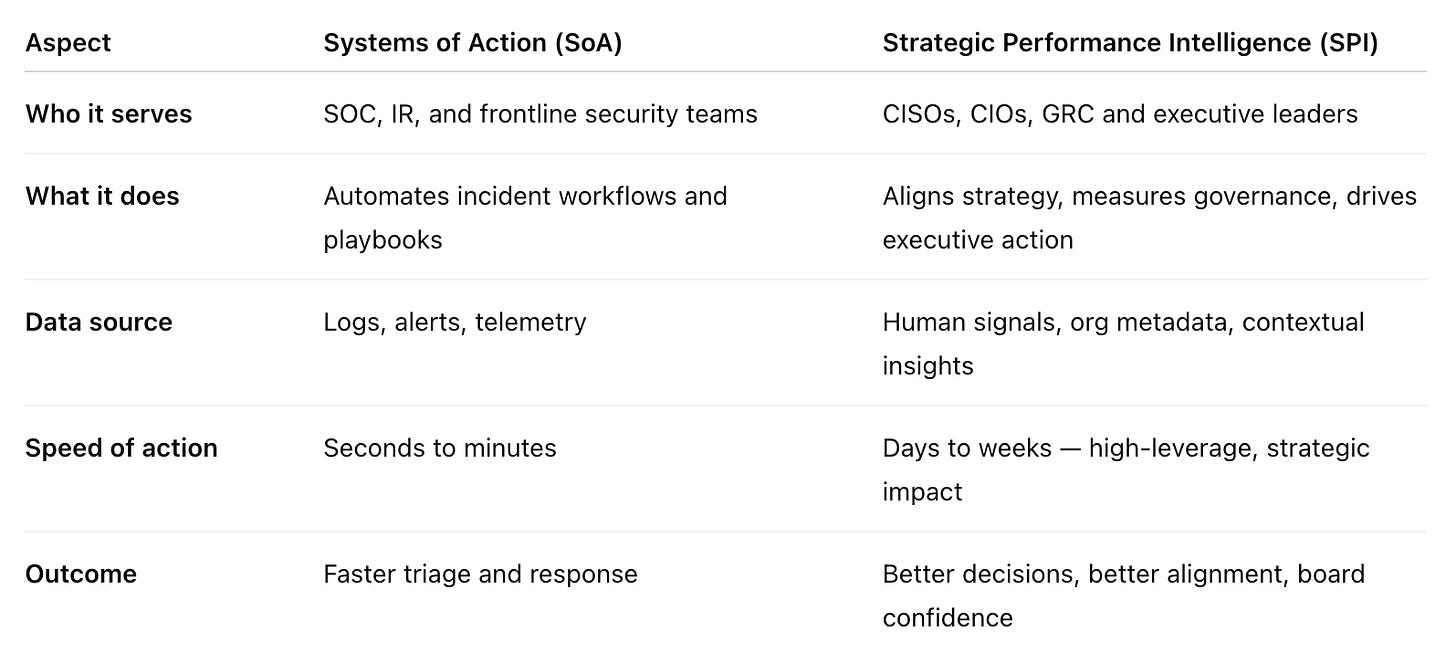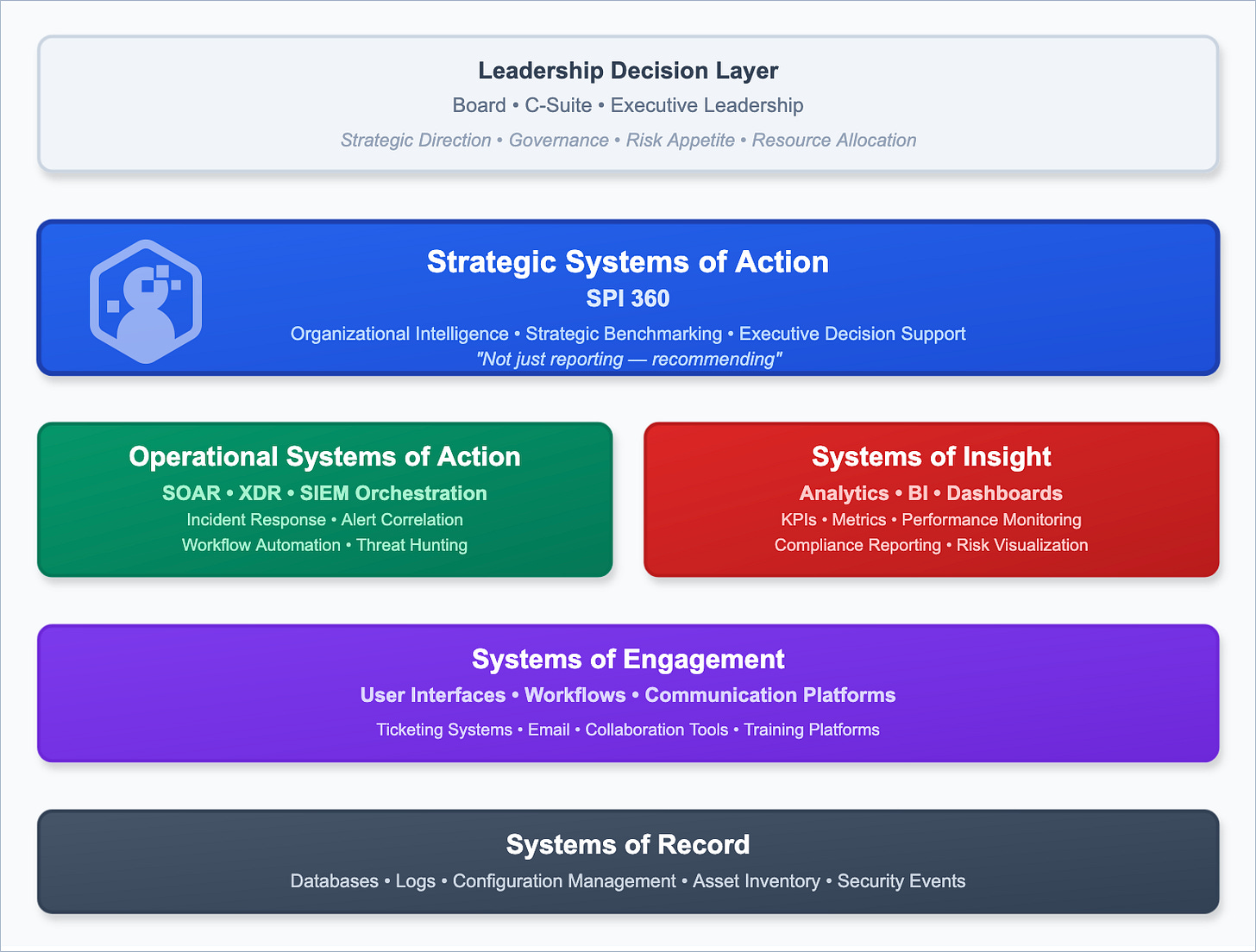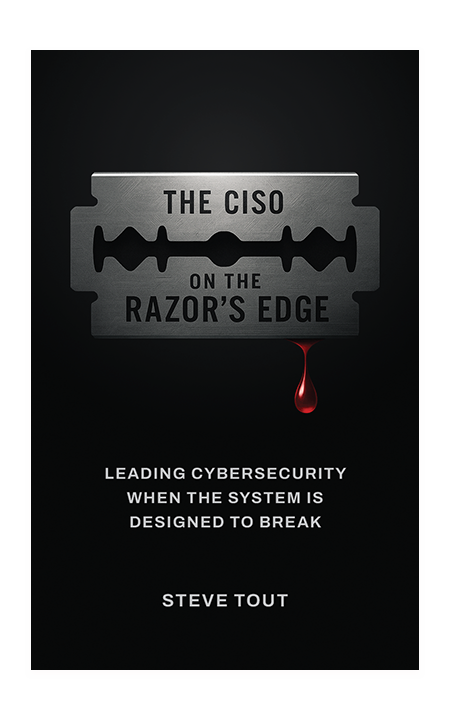SoA Is Not Enough
Why Cybersecurity Leadership Needs Its Own System of Action
For years, security operations teams have been overwhelmed with alerts, false positives, and manual workflows. The industry’s response? Automation.
From SOAR to XDR, a new generation of Systems of Action (SoA) has emerged—platforms that do more than just store or visualize data. They act on it. Automatically. Intelligently. And often, without human intervention.
These systems have transformed operational security.
But they’ve left a critical layer behind:
Leadership.
CISOs and CIOs are still stuck in the dark—navigating fractured orgs, misaligned strategies, outdated frameworks, and political minefields with little more than dashboards and decks.
While the tools below them have evolved, the systems above them—those meant to support executive decision-making—are missing.
It’s time we fix that.
The Automation Revolution Has a Blind Spot
Let’s be clear: SoA tools have added massive value.
In security operations, they've helped teams:
Correlate signals across SIEMs
Automate tier-one incident response
Standardize workflows and reduce response times
That’s real progress. But SoA’s impact is mostly confined to the frontlines—SOC analysts, IR teams, alert queues.
The executives responsible for governance, accountability, and resilience?
They’re still preparing for board meetings manually.
Still leading transformations without a compass.
Still drowning in dashboards that offer data—but no direction.
That’s the blind spot.
What SoA Gets Right—and Where It Stops Short
SoA platforms like ReliaQuest, Splunk, and Palo Alto’s Cortex solve a very different problem: how to act quickly in the face of operational noise.
But they are not designed to measure strategic health, leadership misalignment, or governance performance.
Here’s the difference:
SoA is built for machines acting on signal.
SPI is built for humans acting on complexity.
Introducing Strategic Systems of Action
At Identient, we call this missing layer a Strategic System of Action—a platform for executive decision-making, not endpoint automation.
This is what SPI 360 was built for:
Measuring organizational entropy
Benchmarking team alignment and execution
Providing board-ready intelligence that doesn’t just report—it recommends
Reference Architecture:
Each layer below SPI 360 supports data collection, engagement, and automation.
But only SPI 360 connects strategic clarity to execution outcomes—from leadership context to enterprise impact.
Each layer below SPI 360 serves distinct operational functions—from data collection and user engagement to automated response and analytical insights. But only SPI 360 bridges the gap between executive strategy and organizational disciplines, translating leadership vision into measurable outcomes across all system layers.
The CISO’s Dilemma: Decisions Without a System
Here’s the brutal truth: Most CISOs don’t fail because they lack tools.
They fail because they’re flying blind.
They can’t tell if their org is aligned.
They struggle to convert board directives into measurable initiatives.
They manage complexity with dashboards that don’t prioritize.
“My dashboards are full. But I still can’t tell if we’re winning.”
You’re not broken.
The system is.
This Isn’t a Product Feature—It’s a Category Shift
SPI 360 isn’t a dashboard upgrade. It’s not a module inside GRC.
It’s a new strategic layer—designed to measure and improve the performance of cybersecurity strategy, and leadership itself.
Just as:
CRM needed Salesforce,
HCM needed Workday,
Cybersecurity leadership now needs SPI.
You don’t need more visibility.
You need decisions with direction.
What Happens When Leadership Has a System Too
When your security leadership has a system of action:
Board reporting becomes proactive, not reactive
Strategy is measurable, not theoretical
Teams align faster. Silos shrink.
The role of the CISO gains legitimacy—and lasting impact
Final Word: Systems of Action Must Rise to the Top
We’ve spent the last five years automating what our frontline teams do.
Now, it’s time to support how our leaders decide.
SPI 360 is the first of its kind:
Not a dashboard.
Not a consultancy.
But a system of strategic action—for cybersecurity executives building resilience when the system is built to break.
Want to go deeper?
Subscribe, join a leadership workshop, or request early access to SPI 360.
Let’s build the new layer of leadership, together.
Ready to Lead at the Strategic Layer?
If this post resonated, there’s more.
My new book — The CISO On The Razor’s Edge — is now available for pre-order on Amazon.
It dives deeper into the systemic challenges CISOs face, the leadership models we need to replace, and how to build a resilient, performance-driven security organization in a world that wasn’t designed for one.
This isn’t a theory book. It’s a field manual for those of us leading cybersecurity when the system is built to break.





